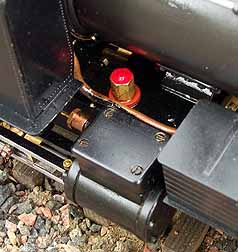
Back to Sidestreet Bannerworks
May 2001
Argyle NA Class 2-6-2T
by Marc Horovitz

In 1897, the 2'6"-gauge Victorian Railways of Austrailia solicited bids for a 20-ton tank locomotive that could be run in either direction without having to be turned. While most locomotives in Australia at that time were British, Baldwin of Philadelphia won the bid. The first two NA class, 2-6-2T locomotives, Nºs 1A and 2A were delivered in 1898. These would be the only NAs built in America. The remainder of the class, Nºs 3A thru 17A, were built at the Newport Workshops of the Victorian Railways from 1900 to 1915, using Baldwin's design and patterns.
Today, engine 6A is preserved and running on the Puffing Billy Railway near Melbourne, along with other NA-class engines. This railway, which is part of the original line that the NAs ran on, was set up as a preservation society in 1955 and has become Australia's leading preserved railways.
The engine
This is a well built, sophisticated model. It has laser-cut frames (to resemble bar frames), sprung axles, cast stainless-steel wheels, and phosphor-bronze bushings at important wear points. Reversing is via full Stephenson's valve gear driven from the second axle and controlled by a reversing quadrant in the cab.
The boiler has a full complement of fittings, including a safety valve under the steam dome, set at 50 psi; a water glass; a pressure gauge; a filler plug beneath the rear sand dome; and a blowdown valve. The engine has working side tanks connected by a balance pipe, so that only one tank need be filled. Water is pumped from the tanks into the boiler via an axle pump on the first driver. A bypass valve resides in the cab.
Butane provides fuel for the single-flue boiler. Gas is carried in the bunker at the rear of the engine.
Performance
The engine had not been run in around 10 years, so I approached this run with some trepidation. When I first ran it a decade ago, its performance was initially disappointing. It took an agonizingly long time for pressure to build and when steam was finally up, it was quickly exhausted. This was ultimately traced to a partially clogged gas jet, one of the most difficult problems (for me, anyway) to diagnose, especially in an unfamiliar engine. It sounded fine and seemed to be doing what it was supposed to, but performance was terrible. However, once the problem was diagnosed and solved, the locomotive was transformed, becoming a lively and powerful runner.
For this run, the engine was duly oiled all round, fueled, and watered. The side tanks were filled with water, too. This can be done from one side, since there is a balance pipe connecting the tanks. The engine was set on the track and the fire ignited through the smokebox door. The burner lit off in an instant. While steam was coming up, I wiped down the track. As the pressure increased, several leaks became evident, probably because of seals and gaskets drying out from lack of use. I tightened the ones I could get to while the engine was hot, and decided to ignore the rest.
After about eight minutes the pressure was up to 40 psi, so I opened the throttle and gave the engine a push. Water spurted from the stack and I noticed what appeared to be a fairly serious steam leak in the left-hand valve cover (which I also decided to ignore -- if the engine didn't go, I could always fix the leak then). The engine did go, though, and took off in a sprightly manner. It has a loud chuff and I could hear it no matter where it was on the railway. The exhaust beats sounded a little off, which I attribute to the leak on the left side. Despite all its problems after years of neglect, the loco ran very well indeed. It is elegant and stately in operation.
An axle pump always takes a bit of getting used to, and this engine's was no exception. I adjusted the bypass valve on the right side of the cab several times before arriving at what seemed a good compromise. Since it has a pump, this engine can be kept in steam indefinitely. However, since it's gas fired, the fire must be shut down from time to time for refueling.
| Specifications | |
| Builder | Argyle Locomotive Works, Australia (Gordon Watson) |
| Date built | 1991 |
| Gauge | 45mm (gauge 1) |
| Scale | 15mm = 1'-0" |
| Boiler | Single-flue, gas fired |
| Fittings | Safety valve, filler plug, throttle, water glass, pressure gauge, bypass valve for feedwater system |
| Fuel | Butane |
| Blow-off pressure | 50 psi |
| Cylinders | Two, double acting D-valve |
| Reversing gear | Stephenson's valve gear controlled from the cab |
| Lubricator | Displacement, beneath the boiler |
| Other features | Full springing, working side tanks with balance pipe, axle pump, blowdown valve |
| Dimensions | Length over body, 17"; width, 4-3/4"; height, 7-7/8" |




Above: Working side tanks are filled with water via the removable filler caps. The safety valve is under the steam dome and a filler plug is concealed beneath the rear sand dome.
Left: An axle pump is worked by an eccentric on the first driving axle.




Above right: Stephenson's link motion controls the valves.
Right: This is an impressive locomotive from any angle.
Back to Sidestreet Bannerworks
This page and its contents Copyright Sidestreet Bannerworks, 2001